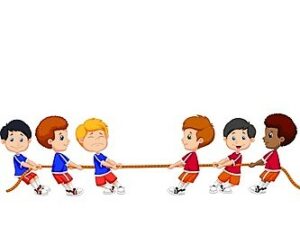The article comprehensively debates about is tension a contact force that transmits through the flexible connectors.
The contact force is exerted when two interacting objects are in physical contact. When we pull the flexible connectors, the contact between us and flexible connectors employ the tension force that transfers our pull to the ends. That’s why tension is conveyed to be a contact force.
Read more about Types of Force
We have understood in the previous articles that when any force is applied to an object, either at rest or moving, it modifies its motion as per Newton’s law. All objects in physical contact drive the contact force to accelerate each other. Depending on the types of objects interacting, they exert diverse contact forces.
The tension force is applied when two objects interact physically, and one of the objects explicitly is the flexible connector like rope, string, cable, etc.


(credit: shutterstock)
Firstly, the muscular force such as pull or push force initiates the procedure of generation tension force. Obviously, we cannot push the cable; otherwise, it will be slack. Instead, we apply the force on a cable by pulling one or both ends. When we stretch the cable’s one end, whereas an object is attached to another end, the tension is exerted on the stretched cable.
That’s how we can pull other objects using flexible connectors without any physical contact. It is because of the tension force that links the two objects using the flexible connectors. Hence, it is classified as a contact force.

(credit: shutterstock)
How Tension is a Contact Force?
The tension is a contact force exerted when two objects interact physically.
The flexible connectors stretch when two objects are in physical contact at their ends. The stretched connectors exert the tension force that transmits the applied force to objects at ends. As per Newton’s second law of motion, the transmitted applied force changes an object’s motion (F = ma).

(credit: shutterstock)
Read more about Torsion Force due to Tension Force
The tension force is exerted only when the flexible connectors stretch from both ends, either by pulling or tying any object. In both cases, physical contact between connectors and other objects occurs. The tension is not developed when only a single or no force acts. That means a pair of pull forces from both ends is liable for the tension force.
If both forces are equal in magnitude, then objects on which pull forces are transmitting are not accelerated to move. For example, the tension force developed on the stretch rope during the game of tug of war.

(credit: shutterstock)
If both teams apply the forces of equivalent magnitude, a rope does not move against the pull from any team in contact. In such a case, the tension forces from a pair of pull forces equal a rope’s weight (mg). i.e.,
T = mg, when a pair of forces is balanced.
Suppose the rope’s one end is tied to the pulley and the other is to the ball, kept hanging. Both pulley and ball are in indirect contact to employ the tension force on the rope. The tension force from the pulley sends its pull downward, whereas the tension force from the ball sends its pull upward, as both are stretching the rope.
If a pair of forces have distinct magnitudes, then the rope accelerates along with one object toward the other.
The tension force is T = mg ± ma when a rope accelerates.
Here, ma is the acceleration of the rope, and mg is the normal force acting on the rope that is counterpart the gravity force since the rope is hanging.
Depending on the magnitude of the unbalanced pair of forces, an object moves either upward or downward.
- If the tension force from the pulley is greater than the ball, then the rope accelerates upward along with the ball; and the tension force is T = mg + ma.
- If the tension force from the ball is greater than the pulley, then the rope accelerates downward through the pulley; the tension force is T = mg – ma.
Is Tension in String a Contact Force?
The tension in string is a contact force as it is in contact with other objects.
The string is one of the flexible connectors that transfer the force over a particular distance along its length. A couple of objects make physical contact with a string by stretching it from both ends, creating tension force.
In a simple pendulum, the string’s one end is tied to a rigid support, and the other is to bob, which swings from its mean position. The swinging leads to stretching the string and exerting the tension force from both objects. Since the forces are balanced, the tension force equals the normal force mg and pendulum string moving in back and forth with constant velocity; without upward or downward acceleration.
Read more about Simple Harmonic Motion

(credit: shutterstock)
In a guitar, the string’s ends are set. When we pluck the string, the exerted tension force transmits towards both ends. Since the ends are fixed, the transmitted tension force is reflected, generating the transverse sound waves from guitar strings. The process involves physical contact between our finger and string, which exerts tension force as contact force.
Read more about Transverse Waves
Also Read:
- Boiling point and molecular forces
- How to calculate force of gravity
- Gravitational force
- Is force a vector quantity
- Electrostatic force and field
- How to find resultant force of two forces
- Atomic force microscopy
- Non conservative force examples
- Central force examples
- What can exert a force

Hello, I’m Manish Naik completed my MSc Physics with Solid-State Electronics as a specialization. I have three years of experience in Article Writing on Physics subject. Writing, which aimed to provide accurate information to all readers, from beginners and experts.
In my leisure time, I love to spend my time in nature or visiting historical places.
Looking forward to connecting you through LinkedIn –